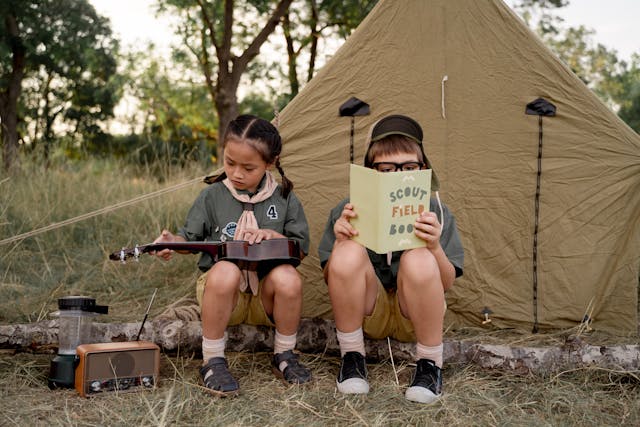Aside from unwinding and exploring together, visiting new places as a family provides you with a wonderful opportunity to nurture your children’s curiosity. Travelling gives your kids the chance to participate in real-world activities and gain insights that textbooks alone cannot provide, deepening their understanding of the world in ways that feel exciting and memorable. With a little planning and creativity, you can transform your journey and holiday activities into fun and experiential learning experiences for your children. Here are some meaningful ways to make learning a natural part of your family travels.
Take Photos of the Various Plants and Flowers You Encounter
Encouraging your kids to observe nature closely can turn an ordinary stroll into a moment of discovery. It helps them see beauty in the small details of the world around them, from the shape of a leaf to the way sunlight filters through the petals. One of the best ways to make their nature observation experience even more enjoyable is by letting them capture those moments through the lens of a camera. Photography offers a creative way for your kids to document the world around them and gives them a sense of purpose and adventure while learning about diversity.
To make the most of this activity, it helps to choose a location where nature takes centre stage. If your travels take you to Singapore, for instance, Changi Airport’s Petal Garden and Topiary Walk offer a vibrant showcase of seasonal blooms and beautifully crafted sculptures that capture the imagination. As your children wander among colourful flowers and intricately shaped plant sculptures, they can take photos of patterns, textures, and colours that catch their eye. As a parent, you can use these moments to discuss the names of different plants and their native habitats. It’s also a good time to bring up the importance of conservation. While this activity is one of the simple things to do in Changi Airport, it leaves children with a deeper appreciation for the natural beauty that flourishes in even the most unexpected places.
Learn Basic Phrases in the Local Language Together
A simple yet rewarding way to involve your children in a new culture is to have them learn a few words and phrases in the local language. Learning simple expressions, such as basic greetings, thank-you’s, or even numbers, can give your kids the confidence to communicate with locals while gaining a sense of the culture around them.
You don’t have to spend hours in formal lessons to make language learning meaningful. In fact, you can practise these phrases during small moments, like ordering food, asking for directions, or saying hello to shopkeepers. To make it more fun, challenge your children to use a new word or phrase each day or see who can remember the most expressions by the end of the trip. Not only does this approach strengthen their communication skills, but it also encourages curiosity and helps them understand local customs.
Visit Different Types of Museums
Museums are treasure troves of discovery. These spaces invite exploration and inspire curiosity in ways that go beyond classroom learning. As such, visiting a variety of museums throughout a trip can help children understand that learning comes in many forms. A science museum, for instance, allows your kids to engage with interactive exhibits that spark curiosity about how things work. An art museum, on the other hand, introduces them to different styles of expression and cultural influences. Meanwhile, historical museums enable your kids to connect with people, events, and inventions that shaped the world they know today.
While visiting these museums, encourage your kids to ask questions, take notes, or sketch what fascinates them. These activities not only let them explore at their own pace, but also help enhance their comprehension and keep them actively engaged during the trip.
Join Hands-On Activities That Celebrate the Destination’s Culture
One of the most enriching ways to introduce children to a new culture is through direct participation. Hands-on activities like making local crafts that highlight traditions and help your kids appreciate different ways of life more memorably. For instance, if you’re in Italy, your family can join pasta-making classes. Here, your children can knead dough, shape pasta by hand, and learn about the role of food in Italian family life. If you’re in Japan, taking calligraphy lessons offers a chance to practise brush strokes while understanding the artistry and mindfulness behind this centuries-old tradition. Through such experiences, your kids gain insight into how cultural practices shape communities and daily life.
Attend Cultural Shows and Festivals
Cultural shows and local festivals provide a vibrant way for children to experience the traditions of a destination in a lively, immersive setting. From colourful parades and folk dances to music performances and seasonal celebrations, these events bring culture to life and turn them into entertaining educational experiences. Attending a festival allows your kids to observe traditional costumes and hear local instruments. They might also be able to witness rituals or performances that have been passed down through generations. It also allows you to use these experiences to explain the significance behind each tradition to your kids and help them understand the values and history that shape the community.
Creating opportunities for your children to learn while travelling doesn’t have to be complicated or time-consuming. With a little creativity and attention to their curiosity, you can transform everyday moments into engaging lessons that inspire wonder and discovery. Encouraging your kids to explore, observe, and participate allows them to gain meaningful experiences that enrich both their journey and their understanding of the world. In the end, these shared experiences help make travel as educational as it is enjoyable for the whole family.




